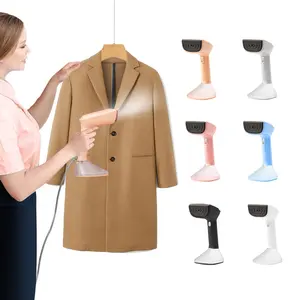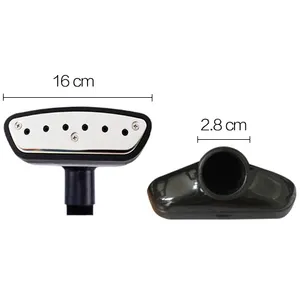What are Garment Steamer Parts
Garment steamers have become an essential tool for both households and various industries, offering a quick and efficient way to remove wrinkles from clothing and fabrics. These devices work by heating water to produce steam, which is then directed through a nozzle to release wrinkles and freshen clothes. As with any appliance, garment steamers consist of various parts that work together to ensure its proper functioning.
The primary components of a garment steamer include the water tank, which holds the liquid that is turned into steam, and the heating element, which heats the water. The steam is then channeled through a hose or nozzle to the clothes. There are also various controls and mechanisms that allow users to adjust the amount of steam and its temperature, ensuring that different types of fabric can be treated safely and effectively.
Garment steamer parts are designed for a range of users, from individuals looking for a convenient home appliance to businesses operating in hospitality or retail that require efficient garment care solutions. These parts are essential for the maintenance and repair of the steamers, ensuring they continue to function optimally. Understanding how each component works and interacts with one another is crucial for both troubleshooting issues and performing routine maintenance.
Types of Garment Steamer Parts
The effectiveness of a garment steamer depends on its parts working in harmony. Here we explore the various types of components that can be found in these devices:
Water Tanks: These reservoirs store the water that will be turned into steam. They can vary in size depending on the model, with larger tanks suited for commercial use where continuous steaming is required.
Heating Elements: This crucial part heats the water to produce steam. It must be capable of reaching high temperatures quickly but also maintaining consistent heat to ensure steady steam flow.
Steam Nozzles and Hoses: These direct the steam from the steamer to the garments. Nozzles can come in various shapes for different types of clothing, while hoses need to be flexible yet durable.
Control Panels: These allow users to adjust settings such as temperature and steam output. They are essential for catering to different fabric types without causing damage.
Pump Mechanisms: In more advanced models, pumps pressurize the water to create a more powerful steam burst, ideal for tougher wrinkles or thicker fabrics.
Soleplates: Some garment steamers come with soleplates made of materials like ceramic or stainless steel, which can help press fabric as you steam for a crisp finish.
Businesses must consider these parts' compatibility with their existing equipment and specific needs when sourcing replacements or upgrades.
How to choose Garment Steamer Parts
Choosing the right garment steamer parts requires careful consideration of your needs and understanding of how these components work within the device. For businesses focused on B2B sales, factors such as compatibility, durability, and performance must be weighed against cost-effectiveness when selecting parts.
When selecting water tanks, consider size and material durability; larger tanks reduce refill frequency but may add weight. The heating element is another critical choice; it should heat up quickly and maintain consistent temperatures. For nozzles and hoses, assess flexibility and heat resistance, ensuring they can reach all parts of a garment without damage.
The control panel should offer intuitive operation while providing precise adjustments for different fabrics—a feature particularly important in commercial settings where a range of garments is processed daily. Pump mechanisms are vital for those requiring strong steam output; however, ensure that this part integrates well with your current system.
Lastly, consider soleplates if your steaming process benefits from pressing capabilities; materials like ceramic provide smooth gliding over fabrics while distributing heat evenly.
Best Garment Steamer Parts on Alibaba.com
Alibaba.com stands as a global marketplace connecting businesses with a vast selection of wholesale garment steamer parts suitable for every need. From robust heating elements that guarantee quick steam production to flexible hoses designed to reach every crease, Alibaba.com encompasses an extensive range tailored to diverse applications—be it household convenience or commercial efficiency.
By leveraging Alibaba.com's platform, businesses gain access to a myriad of suppliers offering parts that cater to specific industry requirements—whether it's portable nozzles for hotel housekeeping or large-capacity water tanks for clothing retailers' back-end operations. Furthermore, Alibaba.com's commitment to facilitating seamless transactions through services like Trade Assurance ensures that purchases are protected until delivery is completed.
Businesses sourcing from this comprehensive online marketplace can rest assured they're accessing some of the most reliable parts available. With features enabling communication in local languages and mobile-friendly buying options, Alibaba.com embodies convenience and confidence for those looking to maintain or enhance their garment steaming capabilities.
Common FAQs for Garment Steamer Parts
What is the average lifespan of a garment steamer's heating element?
The lifespan of a heating element in a garment steamer can vary based on the frequency of use and quality of the part. Generally, with proper maintenance, a heating element can last several years.
Can I replace the water tank on my garment steamer?
Yes, water tanks on garment steamers can typically be replaced. It is essential to select a tank that is compatible with your specific model for proper functionality.
Are there universal nozzles available for different brands of garment steamers?
Universal nozzles may be available, but it is crucial to ensure they fit the hose connection and provide adequate steam flow for your particular steamer brand and model.
How do I choose the right soleplate material for my garment steamer?
The choice of soleplate material depends on your preferences for glide and heat distribution. Ceramic soleplates offer smooth gliding and even heat, while stainless steel is durable and provides quick heat-up times.
What should I consider when selecting a pump mechanism for my commercial garment steamer?
When selecting a pump mechanism, consider the steam output pressure required for your applications and ensure the pump is compatible with your steamer model.
How do I know if a control panel is compatible with my garment steamer?
Compatibility of control panels can be determined by checking the specifications provided by the manufacturer or consulting with the supplier to ensure it matches your steamer's requirements.
How often should I replace hoses on my garment steamer?
Hoses should be inspected regularly for wear and tear and replaced when signs of damage or degradation are evident to prevent steam leaks or safety hazards.
Are there eco-friendly options for garment steamer parts?
Eco-friendly options may be available depending on the manufacturer and supplier. These could include parts made from sustainable materials or designed with energy efficiency in mind.
Can I purchase parts for an older model garment steamer?
Parts for older models may still be available through certain suppliers. It's best to check with multiple vendors to locate the specific parts needed for vintage or discontinued models.
What is the importance of having an adjustable thermostat in a garment steamer part?
An adjustable thermostat allows for precise temperature control when treating different fabric types, preventing damage to delicate materials and ensuring efficient wrinkle removal.
Is it possible to get custom-sized water tanks for garment steamers?
Custom-sized water tanks may be possible to obtain through suppliers that offer customization services. However, it's important to ensure that any modifications do not impact the steamer's performance.
Do garment steamer parts come with installation instructions?
While some parts may come with installation instructions, others might not. It's advisable to consult with technical support or a professional if you are unsure about installing a part correctly.







































 浙公网安备 33010002000092号
浙公网安备 33010002000092号 浙B2-20120091-4
浙B2-20120091-4